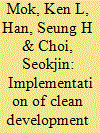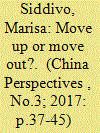|
|
|
Sort Order |
|
|
|
Items / Page
|
|
|
|
|
|
|
| Srl | Item |
| 1 |
ID:
127273


|
|
|
|
|
| Publication |
2014.
|
| Summary/Abstract |
As government and industry plan to reduce energy consumption in building stock, there is a need to forecast the uptake of retrofit packages across building stock over time. To address this challenge a diffusion model was set up and applied to office building stock across New South Wales (NSW) in Australia, accommodating a high spatial resolution and temporal capability for projecting uptake of technology packages characterised by multiple variables. Six retrofit packages were set up for the diffusion model, which ranged from inexpensive services and manuals through to mid-priced packages involving energy efficient T5 lighting and solar hot water through to expensive packages such as chilled beams and Solar PV. We evaluated the model using a base case and two policy programs, representing the Green Building Fund and Environmental Upgrade Agreements. These were recent incentive programs funded by the Australian government to accelerate the uptake of retrofit packages, by providing financial support to upfront expenditures and removing barriers to retrofit. By forecasting uptake of each retrofit package to 2032 under each program, we demonstrate how the model can be a valuable resource in tailoring expensive government programs and increasing their effectiveness.
|
|
|
|
|
|
|
|
|
|
|
|
|
|
|
|
| 2 |
ID:
127275


|
|
|
|
|
| Publication |
2014.
|
| Summary/Abstract |
Greenhouse gas emissions due to human activities are the main contributors to global climate change, a problem that should not be ignored. Through the clean development mechanism (CDM) introduced under the Kyoto Protocol, developing countries are able to earn certified emission reduction (CER) credits through a myriad of emission reduction projects. This study aims to explore the potential of implementing CDM projects in the construction and built environment (C&BE) industry, which has been criticized for not only consuming an enormous amount of resources, but also for contributing to adverse environmental health. In this research, we limit the boundary of the C&BE industry to include the planning, procurement, construction, occupation and refurbishment/demolition phases of a project's life cycle. Surveys and in-depth follow-up interviews with experts have generated useful insights pertaining to CDM potential and its adaptation into the C&BE industry. From this foundation, this paper evaluates the current obstacles to CDM and presents feasible suggestions to increase CDM projects related to the C&BE industry.
|
|
|
|
|
|
|
|
|
|
|
|
|
|
|
|
| 3 |
ID:
156082


|
|
|
|
|
| Summary/Abstract |
China is equipping itself with a mid-long-term strategy to sustain its manufacturing sector in the face of potential challenges brought about by “disruptive” technologies. According to most analysts, disruptive technologies such as 3D printing, the Internet of things (IoT), big data, and robotics are going to modify the “shop floor” and re-allocate the functions and roles of firms empowered in the global value chains (GVCs). In China, scholars, state officials, and the entrepreneurial community have profoundly analysed the impact that disruptive technologies can exert on their firms’ role in the global value chains, reaching the conclusion that the country has to frame a policy to hedge that risk. This paper aims to provide an overview of the debate stirred up by the confrontation of the national manufacturing sector with the introduction of new technologies. The debate, which has involved many institutional and economic actors, has influenced the industrial plans recently drawn up by the Ministry of Industry and Information Technology (MIIT).
|
|
|
|
|
|
|
|
|
|
|
|
|
|
|
|
|
|
|
|
|